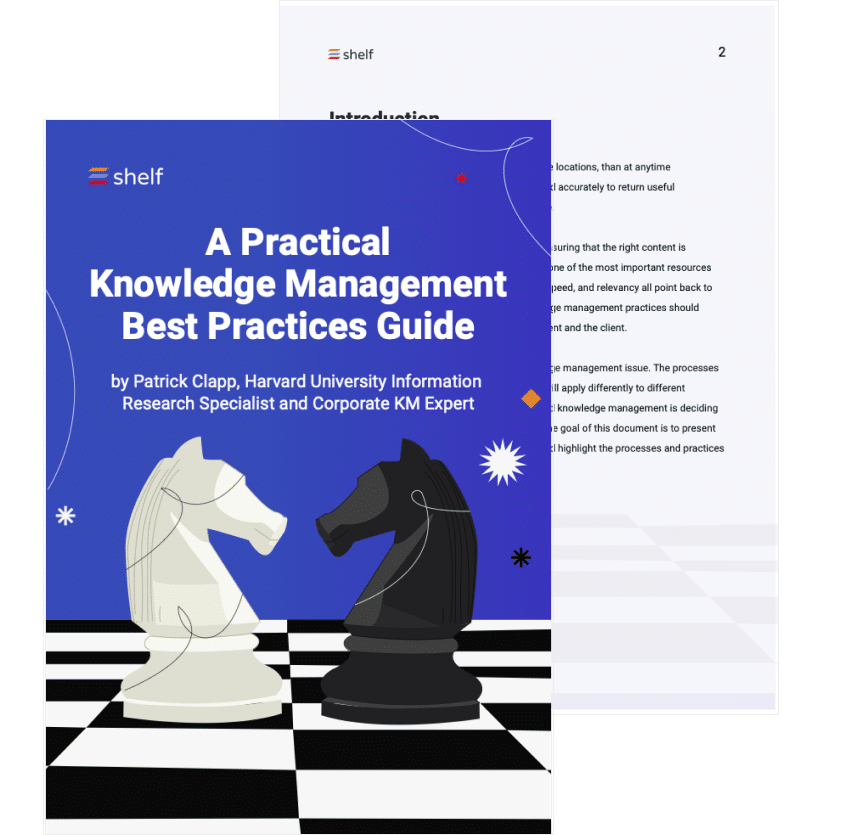Need an organized way for your company to capture, distribute, and effectively use knowledge? You need to design, implement, and maintain a knowledge management system.
A knowledge management system is how the people, processes, and technology related to knowledge in your organization work together; a KM system can be simple or complex, its design should ultimately help your business effectively meet its goals.
KM systems and other IT systems store important information about your organization, your employees, and even your customers. Since even small businesses are becoming more data-driven, KM systems are growing in popularity.
If your company has invested in knowledge management software or team members, at some point you will need to take a step back and make a few tweaks.
In this post, we’ll cover 3 tips on how to maintain your knowledge management system the right way.
1Maintain a knowledge management system by optimizing your KM team
So, who will maintain a knowledge management system? It depends. Each KM team is different, and the roles you need will depend on the size of your organization and the scope of your KM operation.
For many enterprises, the KM system creation and maintenance falls on a knowledge manager or operations manager’s plate. They will review how the system is performing over time, the best knowledge management software for the job, and apply tweaks to the system as needed.
As a part of managing a knowledge management system (people, process, technology), it’s best to document everything as part of a larger knowledge management framework.
Essentially a knowledge management framework will include your KM system in addition to applying knowledge governance standards and a few other rules. Check out our post, Creating a Knowledge Management Framework to learn more.
Ensure each team member has clearly defined roles and responsibilities
To keep your system running smoothly, you should have a team of knowledge management stakeholders to offer input on knowledge management software, how knowledge is integrated into their workflows, and general feedback on content.
Your knowledge manager and technical admins may set up and monitor your overall KM system, but content contributors and even customers should be considered part of your ‘knowledge’ team.
If your goal is to improve knowledge quality over time, you must include people who come into contact with your knowledge management tools and articles, FAQs, and other content types.
Defining roles and responsibilities for your team is a key part of the content maintenance process. A general outline of roles and responsibility will help define who subject matter experts are, and who will be responsible for creating and maintaining content.
Check out our post on KM roles and responsibilities for how to set up your knowledge management team for success.
2Maintain a knowledge management system by ensuring you have the right KM tool
The right knowledge management tool—your central source of truth for knowledge—can make or break your entire knowledge management system. There are many different types of knowledge management software on the market today…and it may be overwhelming;
A lot of the knowledge management products do similar things, but many act as modules of larger systems, like project management tools with a knowledge component.
These tools are unboundedly helpful but you need a source of truth that people recognize and go to for internal or public-facing knowledge.
Here’s the problem with not having a source of truth in your KM system: you can’t maintain a bunch of knowledge silos. When your customer support reps need to access knowledge, they shouldn’t have to search through an out of date intranet site, a difficult-to-search knowledge base, or worry about getting a Confluence login.
A knowledge management platform is the core of enterprise knowledge management systems, because they contain the advanced features needed to integrate/surface knowledge, as well as the AI and analytics to keep content up to date.
You can start with a simple knowledge base, but the key to maintaining your overall KM system is to avoid knowledge silos wherever possible.
3Maintain a knowledge management system by identifying gaps in knowledge
To maintain your knowledge system, you must identify gaps, areas of improvement. Take content in your knowledge base (like a simple wiki) as an example. In the past, knowledge teams had to conduct surveys, check in with employees, or beg for feedback on content quality.
Enterprise knowledge management platforms can now automate knowledge work using AI and machine learning to identify gaps in existing content. The gaps between questions and answers can be the difference between keeping a customer happy and losing them to a competitor.
If you already support customers in a B2C industry, you absolutely need the latest technology in your knowledge management system to help you identify these gaps and create content priorities.
So take a look at your current knowledge management software in use. Is it helping you prioritize knowledge work? Some knowledge management software includes basic content analytics capabilities, but few can identify empty searches or content that simply isn’t being used.
Start with knowledge management best practices
Knowledge management system maintenance is not a one-time task—you need to continually review what you have designed to ensure you always follow KM best practices.
As your business grows and changes, so will your KM system and the tools and people your company requires. Schedule time to regularly review your team (and knowledge management software) on a regular basis.
If you apply a few simple KCS best practices to your system design, you ensure customers always have great answers—anytime, anywhere.
.





